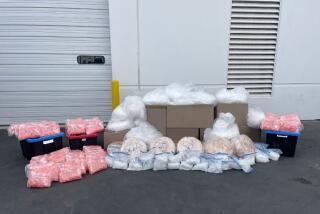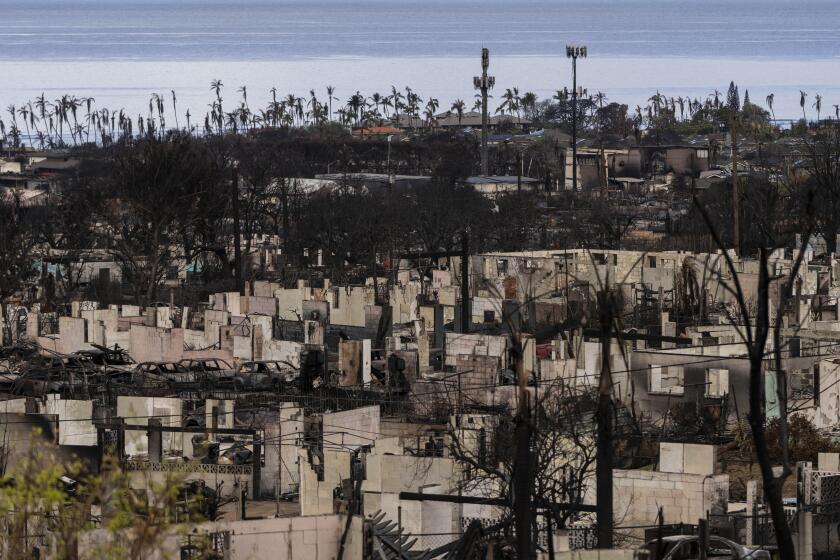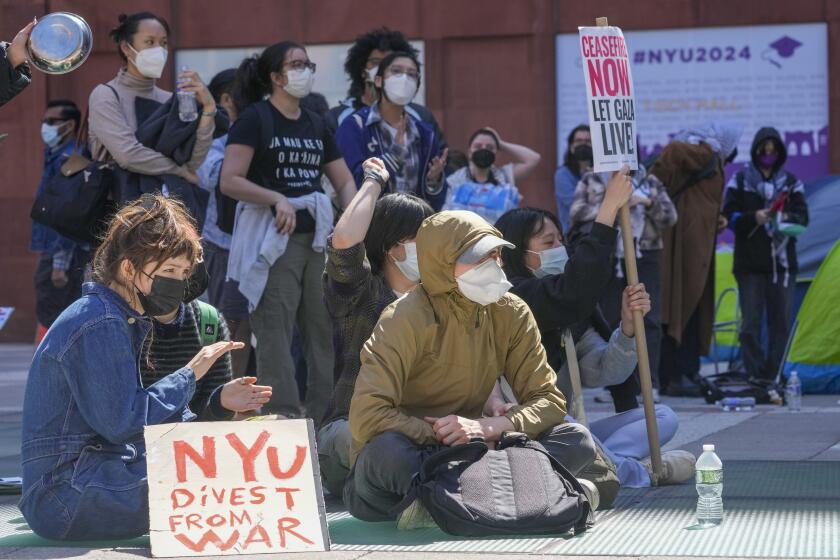Acquaintances Link McVeigh to Drug Deals
In the months before the Oklahoma City bombing, Timothy J. McVeigh was selling an illegal drug that is known to street users and law enforcement agents as the poor man’s cocaine, according to three people acquainted with him in Arizona.
Those acquaintances said McVeigh, the chief suspect in the bombing of the Alfred P. Murrah Federal Building, sold quantities of the powerful, addictive stimulant, called crystal methamphetamine, while he lived in the desert town of Kingman.
Two of the sources, contacted independently in Oklahoma and Missouri, fled Kingman in February after a bomb exploded, damaging the house in which they had lived together. They said they suspect McVeigh or his drug-business associates were responsible for the blast.
A McVeigh connection to the drug trade could help shed light on one of the central questions in the bombing investigation--how the suspect earned money to pay his expenses in the weeks and months before the April 19 attack.
Also, piercing the circle of those involved in the drug sales could provide authorities with the names of more of his associates who might know something about the planning of the Oklahoma City explosion.
“I know he was selling it . . . “ said Ralph (Rocky) McPeak, who acknowledged spending a lot of time with McVeigh in late 1994 and early 1995. “When I met him (last year), he was wired up. He couldn’t stand still.”
It was in April, 1994, that McVeigh quit his last known formal job as a $5-an-hour yard hand at a hardware store in Kingman. During the next 12 months, McVeigh is known to have traveled extensively by car in the Midwest and Southwest, staying frequently in motels--twice in Kingman--and sometimes carrying significant amounts of cash. So far authorities have determined that he sold surplus military paraphernalia at gun shows and by mail, but how much money he might have earned that way is unclear.
The drug, also known as “crystal meth,” or “crystal,” is derived from the powder form of methamphetamine. Compared to cocaine, it is inexpensive to produce. When smoked, typically through a six-inch glass pipe, the translucent crystals, the size of rock candy, produce an intense euphoria that experts say can last for up to 16 hours.
Authorities in Kingman said there is a brisk business in the drug locally, with one-fourth of a gram costing as little as $20.
John W. Coyle III, who until this week served as McVeigh’s court-appointed lawyer in the period following the Oklahoma City bombing, said he was not aware of any drug involvement by his former client. “I don’t know (of it),” Coyle said. “And if I did, I couldn’t comment on that.”
Federal sources familiar with the investigation of the Oklahoma City bombing said that, to their knowledge, McVeigh was not involved in “large-scale” trafficking of crystal methamphetamine. The sources declined to respond to questions about whether the suspect had a role in smaller levels of trafficking.
McPeak is among those identified by various sources in Kingman as a frequent McVeigh associate during the suspect’s time in Arizona. McPeak’s association with McVeigh is of added significance because of the bombing incident in Kingman in February, which damaged McPeak’s house and drew renewed attention from investigators because of the Oklahoma City blast.
McPeak moved from Kingman to the state of Oklahoma early this year. He later moved to rural Missouri. He reluctantly agreed to meet with Times reporters recently after they located him there.
During a three-hour interview, in which he repeatedly emphasized his desire to maintain a low profile, McPeak acknowledged that he and McVeigh were together at least 20 times in Kingman, often at a house frequented by others buying, selling or using crystal methamphetamine.
Moreover, both McPeak and his estranged wife said in separate interviews that some of the same people who had frequented the house also designed and detonated explosive devices.
Authorities came in contact with McPeak and, peripherally, with McVeigh after the unusual explosion damaged McPeak’s rented house along U.S. Route 66 in Kingman on Feb. 21.
Records and interviews show that the blast blew out the McPeak house’s south-facing windows, unhinged kitchen cabinets and obliterated a large crushed-velvet chair that had been left outside overnight. An investigation report compiled by Mohave County sheriff’s detective Eric Cooper said the blast occurred between 5 a.m and 5:30 a.m. and came from a device detonated on the ground about 11 yards behind the residence. The explosion left a “crater, which was approx. 1 foot deep” and 3 feet in diameter, according to Cooper’s report.
“The explosive used had to be a high explosive to create this size of a crater,” Cooper wrote, adding that “fragments of plastic container” were found in the dirt at the center of the crater.
Laboratory tests taken from the explosion site in McPeak’s back yard have found that the bomb was made up of ammonium nitrate fertilizer and fuel oil, according to Doug Bradley, an investigator with the Kingman Fire Department.
Bradley acknowledged that this is the same basic recipe, also placed within plastic containers, that federal authorities believe was used to construct the 4,800-pound bomb that devastated the federal building in Oklahoma City.
The so-called ANFO mixture of ammonium nitrate and fuel oil was confirmed by an Arizona state police lab, on April 24, five days after the Oklahoma City bombing, according to a law enforcement official familiar with the matter.
McPeak, 34, told The Times that he suspected that McVeigh played a role in the explosion at his house for a variety of reasons. He said McVeigh was displeased about an aborted business venture. He said the two also had a disagreement over a mutual friend’s stolen credit card. He said he also had disputes with others who stayed at the drug-dealing house in Kingman that he and McVeigh had frequented.
McPeak said that, when he led Cooper and another officer to the drug-dealing house to find a man believed to be a likely suspect, McVeigh was among those present.
Cooper noted in his report that he followed McPeak to the drug-dealing residence on the morning of the blast at McPeak’s house. According to McPeak, two other men in that house said they had been up until late in the night--discussing how to make and detonate bombs. The two denied that they had set off the device at McPeak’s house and McVeigh said nothing to him that morning, McPeak said.
Cooper wrote in his report that, when he and another officer interviewed a resident of the house hours later that same day, the man confirmed that “some explosives” had been displayed there the night before.
The investigation of the Kingman blast remains open. After the Oklahoma City explosion, investigators initially questioned whether it might have been a test or precursor of the later explosion, but since then, they have considered other possible motivations, including personal disputes.
McVeigh’s new lawyer, Stephen Jones, was not available for comment Wednesday.
Regardless of the motivation for the bombing at McPeak’s house, it was viewed as highly unusual by investigators.
“It’s a small community,” said Bradley, the Kingman Fire Department investigator. “We just don’t have bombs go off.”
McPeak’s friendship with McVeigh was corroborated during separate interviews with McPeak’s estranged wife, his mother-in-law and a priest in a Kingman church where McPeak visited often. The wife, Wanda L. McPeak, and her mother, Patsy Crow, said they were aware of McVeigh’s selling of crystal methamphetamine.
Naming a close acquaintance, Wanda McPeak said: “That’s where (he) was getting his crystal--from Tim.”
Wanda McPeak said her husband and McVeigh became fast friends during the time her family lived in Kingman, from mid-September, 1994, to late February of this year.
“We were starting an iron salvage business,” Wanda McPeak said. “And Rocky and him was going to go into business with each other. . . . That’s all he would talk about, was Tim this, and Tim that.”
Said Father Lawrence Falance, a priest who knew McPeak and also runs a Kingman homeless shelter where the McPeaks once lived for three weeks:
“One day he (McPeak) came to me and said: ‘I met a guy down at the trailer park, his name is McVeigh. He said he’s interested in my (salvage) business.’ ” Falance said that he last spoke with McPeak in late February.
Falance, Ralph McPeak and Wanda McPeak each told The Times that law enforcement authorities have not sought to question them about McVeigh.
Times staff writers Ronald J. Ostrow in Washington and Richard A. Serrano in Oklahoma City contributed to this story.
* NICHOLS CHARGED: Terry L. Nichols is charged in Oklahoma City bombing. A17
More to Read
Start your day right
Sign up for Essential California for news, features and recommendations from the L.A. Times and beyond in your inbox six days a week.
You may occasionally receive promotional content from the Los Angeles Times.







